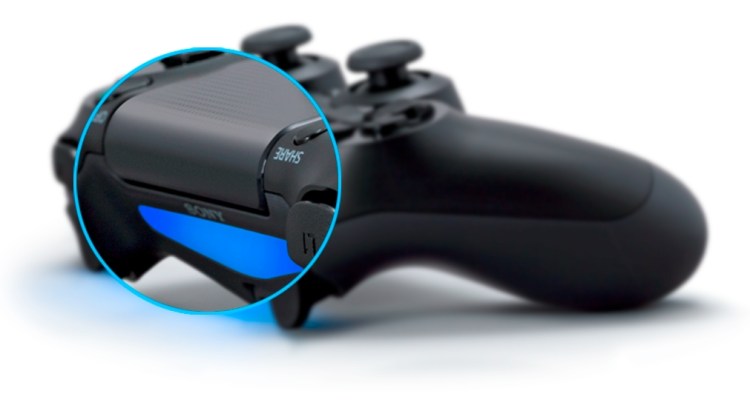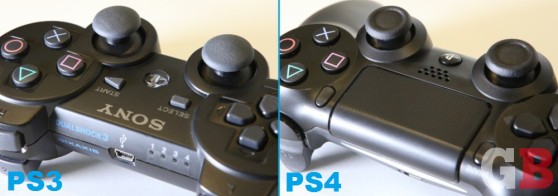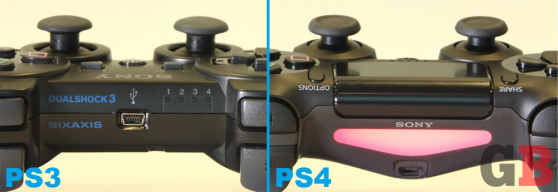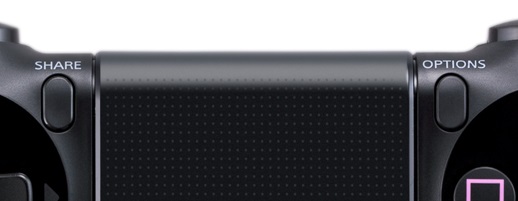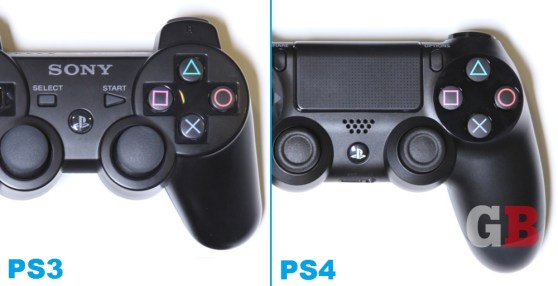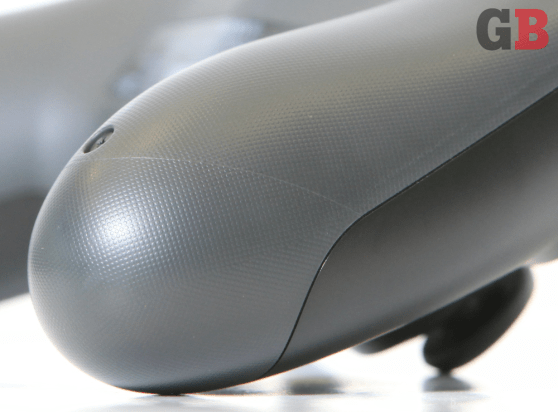This is part of our ongoing series about games and trends of the upcoming next generation. For the Xbox One version of this article, go here.
The PlayStation 4 controller:
- Part 1: What could’ve been
- Part 2: What’s new with the analog sticks and D-pad
- Part 3: What’s new with the buttons and triggers
- Part 4: A close look at the touchpad, light bar, and everything else
The changes to the PlayStation controller that we outlined over the last three articles in this series [check the links above] are enough to make the PS4 version much superior to its PS3 counterpart. People would be nutso to argue that. And we’re not done discussing every little upgrade, either.
But when gamers start bringing home the PlayStation 4 on Nov. 15, the first thing they will notice about its DualShock 4 controller won’t be the new ridges on the analog stick tops. Or the deeper D-pad. Or even the trigger-shaped shoulder buttons. It will be the black slate sitting right in the middle where the word “Sony” used to be — the new touchpad.
Let’s take a closer look.
The touchpad
The DualShock touchpad is a small surface that you can press and swipe on, similar to the equivalent on a laptop.
You might not have realized this, however, but it is also one giant button. It only has one general click, but the system knows where you’re pushing. This enables developers to map different parts of the touchpad to be different “buttons” that you can press. For example — and this is something launch title and first-person shooter Killzone: Shadow Fall does to control its OWL drone — a game can have four commands here, one on each edge (top, bottom, left, right). So if you press down on the right side of the touchpad, you could activate a different behavior than if you press down on the left side (and so on).
When discussing accessibility and more mainstream gaming, the last thing a modern console controller needs is more buttons. Don’t gamers have enough to think about? “Initially, I was skeptical about the touchpad,” Shadow Fall director Steven ter Heide told GamesBeat in one of our exclusive interviews. (His studio, Guerrilla Games, contributed a lot of feedback to the DualShock 4’s design.) “You’d have to lift your thumbs off of the sticks to control it, so what kind of things could you do with it? Would it feel gimmicky? How responsive is it? How accurate is it? Is the area large enough?”
Sony tried many different variations of the touchpad — see part one of our series for some of the crazier ideas, including moveable panels — but ultimately settled on something that wouldn’t alter the basic blueprint of the PlayStation controller too greatly. Because it fits into the existing DualShock design, it’s not that big — much smaller than the Wii U’s GamePad, as a comparison — so it has limits to what it can do. But Sony’s developers see a bigger, long-term picture here. “I think it’s one of those features that’s very forward-looking,” said ter Heide. “We can come up with things that work right now, but maybe a year down the line, people will come up with more exciting uses and even better functions. They’ll integrate it even better into their games. It doesn’t feel like it’s something gratuitous or that shouldn’t be there.”
The light bar
The DualShock 4 is also a simplified version of the PlayStation Move (not the archaic Sixaxis) motion-based controller and works in conjunction with the separately sold PlayStation Camera. So, similar to the original Nintendo Wii’s Wiimote, you will have just one device for both traditional and motion controls.
The PS Camera senses your position by communicating with the LED-powered light bar that’s sitting between the shoulder buttons on top of the DualShock 4. Technologically speaking, this doesn’t work that differently than the PS3 Move, except that it’s slightly less precise and doesn’t pick up depth. “We don’t want the controller to be flying around the room,” said Toshimasa Aoki, the manager of Sony Computer Entertainment’s product planning department, in an exclusive interview with GamesBeat. “It’s a more simple PlayStation Move usage. Instead of detecting X, Y, and Z [axes], it’s detecting just X and Y — where you are in the room.”
Like with the PS3 Move, the PS4 light bar emits a baby-soft glow and can change colors according to what the developers want to display. In Shadow Fall, for example, this represent your health status: green at first, yellowish to orange when getting shot, and red when dead.
Thankfully, the golf-ball-on-a-stick design of the old PS Move is gone. “We didn’t want a big sphere [on the DualShock 4],” said Aoki with a laugh. But the odd thing is, the light bar is actually pointed and angled away from the player, aiming a little downward toward the floor. Sure, it’s not as out there as PS Move’s giant bulb, but it might be a bit too subtle. We asked Aoki about this, but naturally, he and his team have already thought this through. “With the very first prototype,” he tells us, “we had the light bar more out, so that you could see it from a top view. But several people mentioned that a lot of gamers play in the dark, and they don’t want something to be too visible. If it’s too bright and distracting, it can break [the game experience], especially if it’s a horror game. So we made it pretty subtle, more secondary. If gamers see it off their hands or on the floor, it’s nice to have, but they don’t have to look down to check on it.”
And why the triangular shape for this “bar”? It was originally a square in early prototypes, but the team felt it made the controller too bulky, like the bottom of the Xbox 360 joypad with its protruding battery pack. This was especially true since the light-bar area also had to accommodate a mini-USB port for charging [see picture above].
The current flat “V” design helps slim things down for the hands that go underneath and to either side. Sony liked the look so much that it made the L2 and R2 triggers a little more triangular as well to match.
The Share and Options buttons
New Share and Option buttons are in, and ol’ Start and Select are out. This seems odd at first. These elder statesmen of buttons have been around for literally decades now, but think about it: How often do you use them to “start” or “select” anything these days? “People still say that there are too many buttons on controllers,” said Aoki on when the team was trying to figure out how to incorporate a new “Share” function. “We didn’t really want to add a new one. So we had a debate about which button is not really used in games. Everybody said Select, of course. Obviously. That was [a big deal for] us to decide to delete one of the buttons that’s been there since the Nintendo era.”
So Options is for most menus (like we used to get from Start), while Share is for showing off gameplay video. “The idea first came from the game teams,” said Aoki. “We were discussing how the PS4 has that second chip that’s recording the game in the background. The idea was that we should be able [access] that simply with one button press, instead of going back to the home menu and using the GUI [graphical user interface] to share. Especially right now, where a lot of users are uploading game videos to websites. It’s becoming a really big thing. Streaming, as well.”
Right now, Share is a dedicated system button, meaning developers can’t take it over to use for their own purposes. It works directly with the console to send out videos and screenshots. “Of course, in the future, we might change that, but currently, it’s dedicated to that sharing feature,” said Aoki.
And what about those developers who do want or need that extra Select button? The answer seems so obvious now. “One of the questions that came up was, ‘Hey, we lost one button. What should we do?’ But our response was always, ‘The touchpad is also a button. It’s clickable.’ Also, if you press on the right or left side [of the touchpad], the game knows. You could change that to different buttons. So you lose one hardware button, but you gain a thousand buttons,” said Aoki with a laugh. “It should be fine. They were like, ‘Oh, yeah, true.'”
The speaker and headset jack
Sony actually considered giving the DualShock 4 an onboard microphone at one point, for gamer-to-gamer voice communications. Instead, it went with a simple headset jack and audio speaker (located right below the touchpad), for the best of Xbox 360’s and Wii’s controller worlds.
“When you are trying to speak while pressing buttons, you get a lot of odd noise [with a controller-based microphone],” said Aoki. “We tested it, but it just didn’t work. But the speaker is nice to have. [It’s] not a must, but a lot of teams said they could send personalized streams out to each controller, and that could be a nice addition.”
The grips
When you first play with the PlayStation 4 controller, you may notice that it feels better in your hands (outside of the previously covered improvements in the analog sticks, D-pad, triggers, etc.). Sony made several tweaks to the grips for a better fit, but they’re almost easy to miss if you’re not paying close attention. “When you just look at the DualShock 4, it may not look that different,” said Aoki. “But when you hold it, it’s really different.”
The grips are longer, as you can see from the photos, and they’re slightly thicker in the back as well. “A lot of people felt that the Xbox 360 controller fits in their hands [better],” said Aoki. “With the DualShock 3, you have to hold it. With the DualShock 4, you don’t really have to hold it. It just stays in your hand. We kind of merged the good parts of the Xbox grip while still keeping that iconic PlayStation shape. ”
It’s no secret that the Japanese tend to prefer smaller gadgets — this was one of the contributing factors to their country’s reluctance to adopt the original, gargantuan Xbox and its matching joypad. Aoki doesn’t think the slightly beefier DualShock 4 will be an issue for that market. “The very first order from the management team was to keep the size dimensions. That’s the Japanese way,” he said, laughing. “But as we did the user tests, the controller became a little bigger. Since we had that data on why we needed to make it a little bigger and heavier, the management team understood. They approved. And [Japanese users during tests] didn’t think it was too big. They felt the size was fine.”
Weight, however, is another matter. [See below]
Besides the extra girth, the grips also received a textured surface on the back. It’s still plastic and not rubberized, but it’s not perfectly smooth like it’s been in the past. “The bottom side is where you sweat a lot,” said Aoki. “We made it a little more textured, so it helps keep from getting slippery after you use the controller for a while.”
The look
From a purely visual, nonfunctional point of view, two things stick out on the DualShock 4. First, the plastic housing is two-toned instead of one consistent color throughout. The front half is a very dark, smooth gray, while the (textured) back through the bottoms of the grips are a lighter gray.
Then on the front of the controller, the two big circles that house the D-pad and face buttons are glossy black. “The buttons feel more colorful [compared to] having them on the matte,” said Aoki.
The overall weight
Sony is well aware that consumers consider the original PlayStation 3 controller, the rumble-less Sixaxis, to be way too light. (“It felt like a toy instead of a device,” said Aoki.) The next iteration, the DualShock 3, picked up some weight, but the DualShock 4 will be even heavier. It’s not heavy, but it definitely feels more substantial and solid. And that almost happened by accident. “The Xbox 360 controller — some people said it was too bulky, but a lot of people said that the weight felt good in their hands,” said Aoki. “We were discussing trying to add weight, which is not something Sony really does. We always go for smaller and lighter. But that was more at the end of our to-do list, because we needed to fix everything else first. After we’d fixed the design and all the features, it became heavier than the DualShock 3. We had more stuff in it. We were thinking about adding weight on top of this, but in the end, it already had a weight that was pretty good.”
According to Aoki, tests in Europe and the U.S. show that users find the DualShock 4’s weight to be “perfect,” but he admits that the Japanese feel it’s a bit heavy. “They’re used to the DualShock 3. There aren’t many Xboxes around in Japan, so people are used to this weight. So, sorry, Japanese people!” he said, laughing.
Killzone: Shadow Fall’s ter Heide agrees with his fellow European gamers. “It’s probably the best controller I’ve had in my hands,” he said. “It’s more responsive and more like a natural extension of myself, which is ultimately what you want in a controller. The thing I like most about it is kind of intangible or difficult to quantify, but it’s that build quality. It has just the right weight. It’s really difficult to nail that, but it just feels right. Of course, this is me working at Sony, so I would be saying that about the controller, but I really do think so.”
Don’t be a bad human being! Catch up on the rest of this exclusive series:
- Part 1: What could’ve been (Monday)
- Part 2: What’s new with the analog sticks and D-pad (Tuesday)
- Part 3: What’s new with the buttons and triggers (Wednesday)
- Part 4: A close look at the touchpad, light bar, and everything else (today)
Photo credits on watermarked images: Ryan O’Donnell
Special thanks to Noah Marshall and Stephen Kleckner for the Photoshop help.
VentureBeat's mission is to be a digital town square for technical decision-makers to gain knowledge about transformative enterprise technology and transact. Learn More
